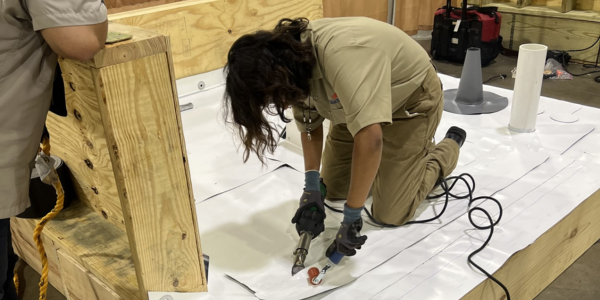How’s the Air Up There?

By Lauren White, RCS Assistant Editor.
Recent events have caused homeowners to evaluate their ventilation needs.
Having healthy air inside homes is a bigger concern now more than ever. As the seasons are changing, more people are spending time indoors, and it’s important that the air they breathe is clean and healthy. The wildfires that have and continue to devastate the western United States have caused the air to be hazardous in many areas and are “prompting calls for new ventilation measures in dwellings,” according to the Wall Street Journal. Many homeowners are thinking about their ventilation needs and how to improve their homes’ ventilation system to keep the air they breathe safe.
While it takes a village to raise a child, it takes a roofing system to maximize the performance and durability of the roof. The shingles, ventilation and insulation products have to work together to “extend the life of your roof, save money on heating and cooling costs, and reduce greenhouse gas emissions,” according to Owens Corning. Moisture is considered to be one of the biggest threats a home can face, but with the proper ventilation, a roof and home can be protected from damage.
Proper ventilation keeps attics cooler in the summer months and reduces moisture and prevents ice dams from forming in the winter months. Owens Corning reports that without proper ventilation, heat buildup in the summer can, “...encourage premature aging and cracking in wood and other roofing materials.” This additional heat can also increase the temperature in living areas, thus reducing energy efficiency.
Moisture can come from two different sources. The first source is bulk water from heavy rains and other extreme weather. Moisture may not be let in during the storm, but if water remains on the roof it can penetrate the surface and get inside the home. If a ventilation system isn’t properly installed, the moisture that infiltrates the home can destroy a roof. Moisture also comes from inside the home, the second source. Every day a family of four produces two to four gallons of water vapor from cooking, bathing and laundry. More than one gallon is produced through breathing and perspiration. The water vapor rises with warm air into the attic, which is a cooler and drier location.
To keep any excess household moisture and heat out of the home and away from the roof, a balanced and properly installed ventilation system is needed. Without this balanced system, the roof and home can suffer significant damage such as premature failure of roofing materials; wet wood; ice dams, which prevent water runoff; metal rust on nail heads; interior damage and growth of mold, spores, fungi and mildew. It’s more difficult for low-slope roofs to shed water, making them more prone to damage. Ventilation is needed to avoid trapping that moisture and causing mold and mildew growth.
There are three main principles of attic ventilation known as the ABC’s of Ventilation - A stands for “Ample Amount,” B is for “Balanced” and C stands for “Control Air Flow.”
Ample amount
It’s important to determine the correct amount of ventilation needed for the attic space of a home. The minimum ventilation ratio is 1:150, meaning the system must have one square foot of vent area for each 150 square feet of attic/roof area. Both the International Building Code (IBC) and International Residential Code (IRC) require a minimum ventilation ratio of 1:150. However, if a vapor retarder is already installed, a ratio of 1:300 is used.
Owens Corning has a vent calculator that helps determine ventilation requirements, in addition to how much exhaust ventilation is necessary for a proper system.
Balanced
After identifying the amount of ventilation needed, the next step is to ensure intake and exhaust are balanced. A balanced system has 50% intake ventilation and 50% exhaust ventilation, which allows the stale air to cycle out through the natural convection system that’s created, eliminating the chances of damage due to moisture. “For a roof, intake is usually achieved through eave and soffit vents, while exhaust is achieved through vents in the gables, deck or ridge,” according to Owens Corning.
The exhaust should never exceed the amount of intake. “Exhaust vents are pulling air out of the attic, which creates negative pressure in the attic without intake vents to make up for the air that is escaping,” Owens Corning explains. If there’s an imbalance between the ventilation sources, “the negative pressure in the attic can suck air from the inside of [the] home,” shared Owens Corning. If this happens, the air that is heated or cooled inside the home gets pulled into the attic through the ceiling, any cracks in the walls and joints in the framing, making the home uncomfortable and wasting energy and money.
Control air flow
To avoid energy bills that are through the roof, literally, it’s necessary to properly air seal and insulate the attic. “Heat flows from warmer to colder areas until the temperature in both places is the same. In the winter, heat travels from indoor heated spaces to adjacent unheated spaces, such as your attic, garage, basement and even the outdoors,” Owens Corning reveals. Adequate ventilation and insulation prevent the flow of heat to other areas during the winter and contains cooled air during the summer, creating a more comfortable home year round.
With wildfire smoke penetrating homes, many homeowners are looking for ways to improve their ventilation systems to keep the air they breathe clean and healthy. Properly installed ventilation systems bring fresh air into the attic and expel excess heat and moisture. As colder temperatures approach, help homeowners keep their homes warm and their heating costs down.
Learn more about Owens Corning in their RoofersCoffeeShop® Directory.






















Comments
Leave a Reply
Have an account? Login to leave a comment!
Sign In